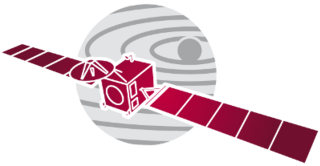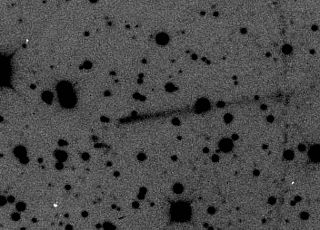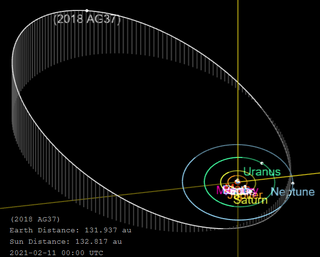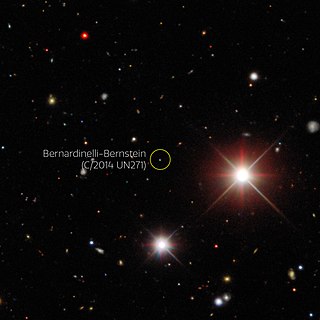Related Research Articles

A comet is an icy, small Solar System body that, when passing close to the Sun, warms and begins to release gases, a process that is called outgassing. This produces a visible atmosphere or coma, and sometimes also a tail. These phenomena are due to the effects of solar radiation and the solar wind acting upon the nucleus of the comet. Comet nuclei range from a few hundred meters to tens of kilometers across and are composed of loose collections of ice, dust, and small rocky particles. The coma may be up to 15 times Earth's diameter, while the tail may stretch beyond one astronomical unit. If sufficiently bright, a comet may be seen from Earth without the aid of a telescope and may subtend an arc of 30° across the sky. Comets have been observed and recorded since ancient times by many cultures and religions.

Comet Hale–Bopp is a comet that was one of the most widely observed of the 20th century and one of the brightest seen for many decades.

Rosetta was a space probe built by the European Space Agency launched on 2 March 2004. Along with Philae, its lander module, Rosetta performed a detailed study of comet 67P/Churyumov–Gerasimenko (67P). During its journey to the comet, the spacecraft performed flybys of Earth, Mars, and the asteroids 21 Lutetia and 2867 Šteins. It was launched as the third cornerstone mission of the ESA's Horizon 2000 programme, after SOHO / Cluster and XMM-Newton.

The Lincoln Near-Earth Asteroid Research (LINEAR) project is a collaboration of the United States Air Force, NASA, and the Massachusetts Institute of Technology's Lincoln Laboratory for the systematic detection and tracking of near-Earth objects. LINEAR was responsible for the majority of asteroid discoveries from 1998 until it was overtaken by the Catalina Sky Survey in 2005. As of 15 September 2011, LINEAR had detected 231,082 new small Solar System bodies, of which at least 2,423 were near-Earth asteroids and 279 were comets. The instruments used by the LINEAR program are located at Lincoln Laboratory's Experimental Test Site (ETS) on the White Sands Missile Range (WSMR) near Socorro, New Mexico.

67P/Churyumov–Gerasimenko is a Jupiter-family comet, originally from the Kuiper belt, with a current orbital period of 6.45 years, a rotation period of approximately 12.4 hours and a maximum velocity of 135,000 km/h. Churyumov–Gerasimenko is approximately 4.3 by 4.1 km at its longest and widest dimensions. It was first observed on photographic plates in 1969 by Soviet astronomers Klim Ivanovych Churyumov and Svetlana Ivanovna Gerasimenko, after whom it is named. It most recently came to perihelion on 2 November 2021, and will return in April 2028.

Philae is a robotic European Space Agency lander that accompanied the Rosetta spacecraft until it separated to land on comet 67P/Churyumov–Gerasimenko, ten years and eight months after departing Earth. On 12 November 2014, Philae touched down on the comet, but it bounced when its anchoring harpoons failed to deploy and a thruster designed to hold the probe to the surface did not fire. After bouncing off the surface twice, Philae achieved the first-ever "soft" (nondestructive) landing on a comet nucleus, although the lander's final, uncontrolled touchdown left it in a non-optimal location and orientation.

Rosetta is a space probe designed to rendezvous with the comet 67P/Churyumov–Gerasimenko, perform flybys of two asteroids, and carry lander Philae until its landing on 67P. This page records a detailed timeline of this mission.

4015 Wilson–Harrington is an active asteroid known both as comet 107P/Wilson–Harrington and as asteroid 4015 Wilson–Harrington.

In astrophysics, a bow shock occurs when the magnetosphere of an astrophysical object interacts with the nearby flowing ambient plasma such as the solar wind. For Earth and other magnetized planets, it is the boundary at which the speed of the stellar wind abruptly drops as a result of its approach to the magnetopause. For stars, this boundary is typically the edge of the astrosphere, where the stellar wind meets the interstellar medium.

The Panoramic Survey Telescope and Rapid Response System located at Haleakala Observatory, Hawaii, US, consists of astronomical cameras, telescopes and a computing facility that is surveying the sky for moving or variable objects on a continual basis, and also producing accurate astrometry and photometry of already-detected objects. In January 2019 the second Pan-STARRS data release was announced. At 1.6 petabytes, it is the largest volume of astronomical data ever released.

The nucleus is the solid, central part of a comet, once termed a dirty snowball or an icy dirtball. A cometary nucleus is composed of rock, dust, and frozen gases. When heated by the Sun, the gases sublimate and produce an atmosphere surrounding the nucleus known as the coma. The force exerted on the coma by the Sun's radiation pressure and solar wind cause an enormous tail to form, which points away from the Sun. A typical comet nucleus has an albedo of 0.04. This is blacker than coal, and may be caused by a covering of dust.
118401 LINEAR, provisional designation 1999 RE70, is an asteroid and main-belt comet (176P/LINEAR) that was discovered by the Lincoln Near-Earth Asteroid Research (LINEAR) 1-metre telescopes in Socorro, New Mexico on September 7, 1999. (118401) LINEAR was discovered to be cometary on November 26, 2005, by Henry H. Hsieh and David C. Jewitt as part of the Hawaii Trails project using the Gemini North 8-m telescope on Mauna Kea and was confirmed by the University of Hawaii's 2.2-m (88-in) telescope on December 24–27, 2005, and Gemini on December 29, 2005. Observations using the Spitzer Space Telescope have resulted in an estimate of 4.0±0.4 km for the diameter of (118401) LINEAR.

354P/LINEAR is a small Solar System body that displayed characteristics of both an asteroid and a comet, and thus, was initially given a cometary designation. Because it has the orbit of a main-belt asteroid and showed the tail of a comet, it was listed as a main-belt comet. But within a month of discovery, an analysis of images by the Hubble telescope suggested that its tail was generated by dust and gravel resulting from a recent head-on collision between asteroids rather than from sublimation of cometary ice. This was the first time a small-body collision had been observed; since then, minor planet 596 Scheila has also been seen to undergo a collision, in late 2010. The position of the nucleus was remarkable for being offset from the axis of the tail and outside the dust halo, a situation never before seen in a comet. The tail is created by millimeter-sized particles being pushed back by solar radiation pressure.

276P/Vorobjov is a Jupiter-family comet discovered on 15 October 2012 by Tomáš Vorobjov on three 120-s images taken remotely using the 0.81-m f/7 Ritchey-Chretien Schulman Telescope located at the Mt. Lemmon SkyCenter via the Sierra Stars Observatory Network in the course of a minor-planet search survey undertaken as part of the International Astronomical Search Collaboration (IASC) school campaigns. After posting on the Minor Planet Center's NEOCP webpage, other observers have commented on the object's cometary appearance. The discovery was announced by the Minor Planet Center on 18 October, three days after the discovery.

C/2013 US10 (Catalina) is an Oort cloud comet discovered on 31 October 2013 by the Catalina Sky Survey at an apparent magnitude of 19 using a 0.68-meter (27 in) Schmidt–Cassegrain telescope. As of September 2015 the comet is around apparent magnitude 6.

Harold Anthony "Hal" Weaver, Jr. is an American astronomer, known for his research into the composition of solar system bodies including comets and Kuiper belt objects.

2018 AG37 (nicknamed FarFarOut) is a distant trans-Neptunian object and centaur that was discovered 132.2 ± 1.5 AU (19.78 ± 0.22 billion km) from the Sun, farther than any other currently observable known object in the Solar System. Imaged in January 2018 during a search for the hypothetical Planet Nine, the confirmation of this object was announced in a press release in February 2021 by astronomers Scott Sheppard, David Tholen, and Chad Trujillo. The object was nicknamed "FarFarOut" to emphasize its distance from the Sun.

2I/Borisov, originally designated C/2019 Q4 (Borisov), is the first observed rogue comet and the second observed interstellar interloper after ʻOumuamua. It was discovered by the Crimean amateur astronomer and telescope maker Gennadiy Borisov on 29 August 2019 UTC.

C/2014 UN271 (Bernardinelli-Bernstein), also simply known as C/2014 UN271 or Comet Bernardinelli-Bernstein (nicknamed BB), is a large Oort cloud comet discovered by astronomers Pedro Bernardinelli and Gary Bernstein in archival images from the Dark Energy Survey. When first imaged in October 2014, the object was 29 AU (4.3 billion km; 2.7 billion mi) from the Sun, almost as far as Neptune's orbit and the greatest distance at which a comet has been discovered. With a nucleus diameter of 137 km (85 mi), it is the largest Oort cloud comet known. It is approaching the Sun and will reach its perihelion of 10.9 AU (just outside of Saturn's orbit) in January 2031. It will not be visible to the naked eye because it will not enter the inner Solar System.
References
- ↑ "Rosetta's Scientific First - Observation of Comet Linear". European Space Agency . Retrieved 13 November 2014.

